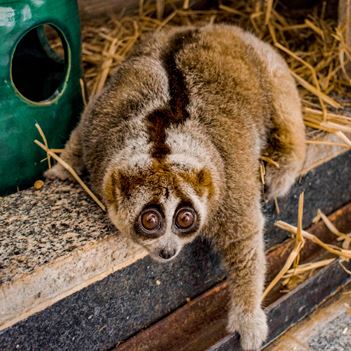Names
(Slow Loris) اسلولوریس :Persian Name
اللوري البطيء :Arabic Name
English Name: Slow Loris
Scientific Name: Nycticebus (a genus of nocturnal primates in family Lorisidae)
General Classification
Kingdom: Animalia
Phylum: Chordata
Class: Mammalia
Order: Primates
Family: Lorisidae
Habitat
Slow lorises inhabit tropical and subtropical rainforests of Southeast Asia including Indonesia, Malaysia, Thailand, and Vietnam. They typically live in dense, moist forests with abundant tree cover. These nocturnal primates move slowly among tree branches
Conservation Status
According to the International Union for Conservation of Nature (IUCN), many slow loris species are categorized as Vulnerable or Near Threatened. Main threats include hunting for illegal pet trade and habitat destruction
Diet
Slow lorises are omnivorous, feeding on insects, sweet fruits, tree sap, young leaves, and small vertebrates. They use their tongue to lick tree sap. Their feeding activity mainly occurs at night
Threats
Primary threats include hunting for pet trade, deforestation due to logging and agriculture, road traffic accidents, and human harassment.
Biological Data
Gestation: About 6 months
Number of Offspring: Usually 1 or 2 young
Maturity Age: About 1 to 2 years
Lifespan: Approximately 10 to 20 years in captivity
Body Length: 18 to 38 cm
Height: Not significant due to arboreal lifestyle
Body Weight: 260 to 600 grams depending on species
Interesting Facts
Slow lorises are the only venomous primates capable of injecting toxin from their elbow glands to deter predators or rivals. Their slow, deliberate movements aid in camouflage and stealth
Introduction
Slow lorises are small, nocturnal primates with large eyes and strong grasping hands that inhabit the tropical forests of South Asia. Their slow movements enable them to forage inconspicuously while avoiding predators. Despite their delicate appearance, they possess a venomous defense mechanism
They play an important ecological role in controlling insect populations and dispersing seeds, thus contributing to forest health and biodiversity. However, their populations have rapidly declined due to human activities, making habitat conservation a crucial priority
Due to their unique biology and behavior, research on slow lorises informs conservation strategies and provides a model for protecting other vulnerable mammalian species

